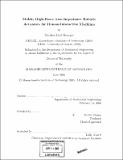| dc.contributor.advisor | Neville Hogan. | en_US |
| dc.contributor.author | Buerger, Stephen Paul, 1976- | en_US |
| dc.contributor.other | Massachusetts Institute of Technology. Dept. of Mechanical Engineering. | en_US |
| dc.date.accessioned | 2006-09-28T15:06:07Z | |
| dc.date.available | 2006-09-28T15:06:07Z | |
| dc.date.copyright | 2005 | en_US |
| dc.date.issued | 2005 | en_US |
| dc.identifier.uri | http://hdl.handle.net/1721.1/34130 | |
| dc.description | Thesis (Ph. D.)--Massachusetts Institute of Technology, Dept. of Mechanical Engineering, 2005. | en_US |
| dc.description | Includes bibliographical references (p. 347-359). | en_US |
| dc.description.abstract | Robots that engage in significant physical interaction with humans, such as robotic physical therapy aids, must exhibit desired mechanical endpoint impedance while simultaneously producing large forces. In most practical robot configurations, this requires actuators with high force-to-weight ratios and low intrinsic impedance. This thesis explores several approaches to improve the tradeoff between actuator force capacity, weight, and ability to produce desired impedance. Existing actuators that render impedance accurately generally have poor force densities while those with high force densities often have high intrinsic impedance. Aggressive force feedback can reduce apparent endpoint impedance, but compromises coupled stability. The common standard for ensuring coupled stability, passivity, can limit performance severely. An alternative measure of coupled stability is proposed that uses limited knowledge of environment dynamics (e.g. a human limb) and applies robust stability tools to port functions. Because of structural differences between interaction control and servo control, classical single-input, single-output control tools cannot be directly applied for design. Instead, a search method is used to select controller parameters for an assumed structure. | en_US |
| dc.description.abstract | (cont.) Simulations and experiments show that this new approach can be used to design a force-feedback controller for a robot actuator that improves performance, reduces conservatism, and maintains coupled stability. Adding dynamics in series to change an actuator's physical behavior can also improve performance. The design tools developed for controller design are adapted to select parameters for physical series dynamics and the control system simultaneously. This design procedure is applied to both spring-damper and inertial series dynamics. Results show that both structures can be advantageous, and that the systematic design of hardware and control together can improve performance dramatically over prior work. A remote transmission design is proposed to reduce actuator weight directly. This design uses a stationary direct-drive electromagnetic actuator and a passive, flexible hydraulic transmission with low intrinsic impedance, thereby utilizing the impedance- rendering capabilities of direct-drive actuation and the force density of hydraulic actuation. The design, construction and characterization of a low-weight, low-friction prototype for a human arm therapy robot are discussed. Recommendations and tradeoffs are presented. | en_US |
| dc.description.statementofresponsibility | by Stephen Paul Buerger. | en_US |
| dc.format.extent | 359 p. | en_US |
| dc.format.extent | 20336327 bytes | |
| dc.format.extent | 20352191 bytes | |
| dc.format.mimetype | application/pdf | |
| dc.format.mimetype | application/pdf | |
| dc.language.iso | eng | en_US |
| dc.publisher | Massachusetts Institute of Technology | en_US |
| dc.rights | M.I.T. theses are protected by copyright. They may be viewed from this source for any purpose, but reproduction or distribution in any format is prohibited without written permission. See provided URL for inquiries about permission. | en_US |
| dc.rights.uri | http://dspace.mit.edu/handle/1721.1/7582 | |
| dc.subject | Mechanical Engineering. | en_US |
| dc.title | Stable, high-force, low-impedance robotic actuators for human-interactive machines | en_US |
| dc.type | Thesis | en_US |
| dc.description.degree | Ph.D. | en_US |
| dc.contributor.department | Massachusetts Institute of Technology. Department of Mechanical Engineering | |
| dc.identifier.oclc | 67767822 | en_US |
